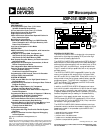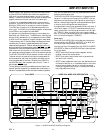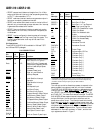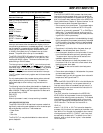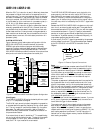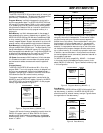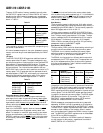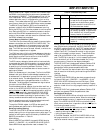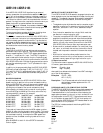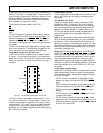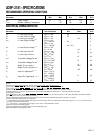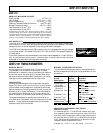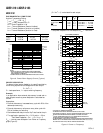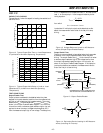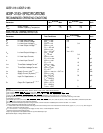ADSP-2181/ADSP-2183
REV. 0
–2–
This takes place while the processor continues to:
• receive and transmit data through the two serial ports
• receive and/or transmit data through the internal DMA port
• receive and/or transmit data through the byte DMA port
• decrement timer
Development System
The ADSP-2100 Family Development Software, a complete set of
tools for software and hardware system development, supports the
ADSP-2181/ADSP-2183. The System Builder provides a high
level method for defining the architecture of systems under devel-
opment. The Assembler has an algebraic syntax that is easy to
program and debug. The Linker combines object files into an
executable file. The Simulator provides an interactive instruc-
tion-level simulation with a reconfigurable user interface to dis-
play different portions of the hardware environment. A PROM
Splitter generates PROM programmer compatible files. The C
Compiler, based on the Free Software Foundation’s GNU C
Compiler, generates ADSP-2181/ADSP-2183 assembly source
code. The source code debugger allows programs to be corrected
in the C environment. The Runtime Library includes over 100
ANSI-standard mathematical and DSP-specific functions.
The EZ-KIT Lite is a hardware/software kit offering a complete
development environment for the entire ADSP-21xx family: an
ADSP-2181 based evaluation board with PC monitor software
plus Assembler, Linker, Simulator, and PROM Splitter software.
The ADSP-2181 EZ-KIT Lite is a low cost, easy to use hardware
platform on which you can quickly get started with your DSP soft-
ware design. The EZ-KIT Lite includes the following features:
• 33 MHz ADSP-2181
• Full 16-bit Stereo Audio I/O with AD1847 SoundPort®
Codec
• RS-232 Interface to PC with Windows 3.1 Control Software
• Stand-Alone Operation with Socketed EPROM
• EZ-ICE Connector for Emulator Control
• DSP Demo Programs
The ADSP-2181 EZ-ICE
®
Emulator aids in the hardware de-
bugging of ADSP-2181 system. The emulator consists of hard-
ware, host computer resident software, and the target board
connector. The ADSP-2181/ADSP-2183 integrates on-chip
emulation support with a 14-pin ICE-Port interface. This inter-
face provides a simpler target board connection that requires
fewer mechanical clearance considerations than other
ADSP-2100 Family EZ-ICEs. The ADSP-2181/ADSP-2183
device need not be removed from the target system when using
the EZ-ICE, nor are any adapters needed. Due to the small
footprint of the EZ-ICE connector, emulation can be supported
in final board designs.
The EZ-ICE performs a full range of functions, including:
• Stand-alone or in-target operation
• Up to 20 breakpoints
• Single-step or full-speed operation
• Registers and memory values can be examined and altered
• PC upload and download functions
• Instruction-level emulation of program booting and execution
• Complete assembly and disassembly of instructions
• C source-level debugging
See “Designing An EZ-ICE-Compatible Target System” in the
ADSP-2100 Family EZ-Tools Manual as well as page 11 of this
data sheet for exact specifications of the EZ-ICE target board
connector.
Additional Information
This data sheet provides a general overview of ADSP-2181/
ADSP-2183 functionality. For additional information on the
architecture and instruction set of the processor, refer to the
ADSP-2100 Family User’s Manual. For more information about
the development tools, refer to the ADSP-2100 Family Develop-
ment Tools Data Sheet.
ARCHITECTURE OVERVIEW
The ADSP-2181/ADSP-2183 instruction set provides flexible
data moves and multifunction (one or two data moves with a
computation) instructions. Every instruction can be executed in
a single processor cycle. The ADSP-2181/ADSP-2183 assembly
language uses an algebraic syntax for ease of coding and read-
ability. A comprehensive set of development tools supports pro-
gram development.
Figure 1 is an overall block diagram of the ADSP-2181/ADSP-
2183. The processor contains three independent computational
units: the ALU, the multiplier/accumulator (MAC) and the
shifter. The computational units process 16-bit data directly and
have provisions to support multiprecision computations. The
ALU performs a standard set of arithmetic and logic operations;
division primitives are also supported. The MAC performs
single-cycle multiply, multiply/add and multiply/subtract opera-
tions with 40 bits of accumulation. The shifter performs logical
and arithmetic shifts, normalization, denormalization, and de-
rive exponent operations. The shifter can be used to efficiently
implement numeric format control including multiword and
block floating-point representations.
The internal result (R) bus connects the computational units so
that the output of any unit may be the input of any unit on the
next cycle.
A powerful program sequencer and two dedicated data address
generators ensure efficient delivery of operands to these compu-
tational units. The sequencer supports conditional jumps, sub-
routine calls and returns in a single cycle. With internal loop
counters and loop stacks, the ADSP-2181/ADSP-2183 executes
looped code with zero overhead; no explicit jump instructions
are required to maintain loops.
Two data address generators (DAGs) provide addresses for
simultaneous dual operand fetches (from data memory and pro-
gram memory). Each DAG maintains and updates four address
pointers. Whenever the pointer is used to access data (indirect
addressing), it is post-modified by the value of one of four pos-
sible modify registers. A length value may be associated with
each pointer to implement automatic modulo addressing for cir-
cular buffers.
Efficient data transfer is achieved with the use of five internal buses:
• Program Memory Address (PMA) Bus
• Program Memory Data (PMD) Bus
• Data Memory Address (DMA) Bus
• Data Memory Data (DMD) Bus
• Result (R) Bus
The two address buses (PMA and DMA) share a single external
address bus, allowing memory to be expanded off-chip, and the
two data buses (PMD and DMD) share a single external data
bus. Byte memory space and I/O memory space also share the
external buses.
EZ-ICE and SoundPort are registered trademarks of Analog Devices, Inc.



